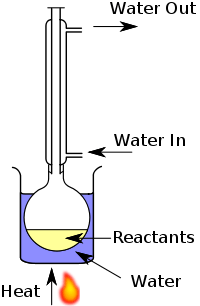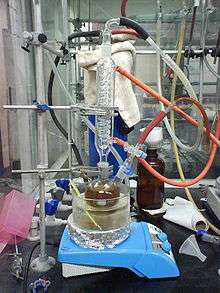Reflux
Reflux is a technique involving the condensation of vapors and the return of this condensate to the system from which it originated. It is used in industrial[1] and laboratory[2] distillations. It is also used in chemistry to supply energy to reactions over a long period of time.
Reflux in industrial distillation
The term reflux[1][3][4] is very widely used in industries that utilize large-scale distillation columns and fractionators such as petroleum refineries, petrochemical and chemical plants, and natural gas processing plants.
In that context, reflux refers to the portion of the overhead liquid product from a distillation column or fractionator that is returned to the upper part of the column as shown in the schematic diagram of a typical industrial distillation column. Inside the column, the downflowing reflux liquid provides cooling and condensation of the upflowing vapors thereby increasing the efficiency of the distillation column.
The more reflux provided for a given number of theoretical plates, the better is the column's separation of lower boiling materials from higher boiling materials. Conversely, for a given desired separation, the more reflux is provided, the fewer theoretical plates are required.[5]
Reflux to regulate energy in chemical reactions

A liquid reaction mixture is placed in a vessel open only at the top. This vessel is connected to a Liebig or Vigreux condenser, such that any vapours given off are cooled back to liquid, and fall back into the reaction vessel. The vessel is then heated vigorously for the course of the reaction. The purpose is to thermally accelerate the reaction by conducting it at an elevated temperature (i.e. the solvent's boiling point).[6]
The advantage of this technique is that it can be left for a long period of time without the need to add more solvent or fear of the reaction vessel boiling dry as any vapour is immediately condensed in the condenser. In addition, as a given solvent will always boil at a certain temperature, one can be sure that the reaction will proceed at a constant temperature. By careful choice of solvent, one can control the temperature within a very narrow range. The constant boiling action also serves to continuously mix the solution, although a magnetic stirring rod mechanism is often used to achieve a uniform solution. This technique is useful for performing chemical reactions under controlled conditions that require substantial time for completion.
The diagram shows a typical reflux apparatus for applying energy to chemical reactions. It includes an optional beaker of water between the reactants and the heat. This is often used as a safety precaution when using flammable reactants and a Bunsen burner in order to keep the flame away from the reactants. In modern laboratories, open flames are avoided due to the many flammable solvents often in use, and electrical heating, (e.g., with a hot plate or mantle) is preferred. Furthermore, a high boiling, thermally stable silicone oil is generally used to immerse the reaction vessel, rather than water which evaporates too readily to be useful for lengthy reactions. Using an oil bath, temperatures of up to several hundred degrees can easily be achieved, which is higher than the boiling point of most commonly used solvents. If even higher temperatures are required, the oil bath can be replaced with a sand bath.
Reflux in laboratory distillation

The apparatus shown in the diagram represents a batch distillation as opposed to a continuous distillation. The liquid feed mixture to be distilled is placed into the round-bottomed flask along with a few anti-bumping granules, and the fractionating column is fitted into the top. As the mixture is heated and boils, vapor rises up the column. The vapor condenses on the glass platforms (known as plates or trays) inside the column and runs back down into the liquid below, thereby refluxing the upflowing distillate vapor. The hottest tray is at the bottom of the column and the coolest tray is at the top. At steady state conditions, the vapor and liquid on each tray is at equilibrium. Only the most volatile of the vapors stays in gaseous form all the way to the top. The vapor at the top of the column then passes into the condenser, where it cools until it condenses into a liquid. The separation can be enhanced with the addition of more trays (to a practical limitation of heat, flow, etc.). The process continues until all the most volatile components in the liquid feed boil out of the mixture. This point can be recognized by the rise in temperature shown on the thermometer. For continuous distillation, the feed mixture enters in the middle of the column.
Reflux in beverage distillation
By controlling the temperature of the condenser, often called a dephlegmator, a reflux still may be used to ensure that higher boiling point components are returned to the flask while lighter elements are passed out to a secondary condenser. This is useful in producing high quality alcoholic beverages, while ensuring that less desirable components (such as fusel alcohols) are returned to the primary flask. For high quality neutral spirits (such as vodka), or post distillation flavored spirits (gin, absinthe), a process of multiple distillations or charcoal filtering may be applied to obtain a product lacking in any suggestion of its original source material for fermentation. The geometry of the still also plays a role in determining how much reflux occurs. In a pot still, if the tube leading from the boiler to the condenser, the lyne arm, is angled upward, more liquid will have a chance to condense and flow back into the boiler leading to increased reflux. Typical results can increase production as high as 50% over the basic worm type condenser. The addition of a copper "boiling ball" in the path creates an area where expansion of gasses into the ball causes cooling and subsequent condensation and reflux. In a column still, the addition of inert materials in the column (e.g., packing) creates surfaces for early condensation and leads to increased reflux.
Reflux in biochemistry
A concentrated solution of ammonium cyanide, refluxed for few days, yields adenine, a component of DNA. This provides a clue about origin of life on earth.[7]
See also
References
- 1 2 Kister, Henry Z. (1992). Distillation Design (1st ed.). McGraw-Hill. ISBN 0-07-034909-6.
- ↑ Erich Krell (1982). Handbook of Laboratory Distillation (3rd ed.). Elsevier Science Ltd. ISBN 0-444-55640-0.
- ↑ Perry, Robert H. & Green, Don W. (1984). Perry's Chemical Engineers' Handbook (6th ed.). McGraw-Hill. ISBN 0-07-049479-7.
- ↑ King, C.J. (1980). Separation Processes (2nd ed.). McGraw Hill. 0-07-034612-7.
- ↑ Gavin Towler & R K Sinnott (2007). Chemical Engineering Design: Principles, Practice and Economics of Plant and Process Design. Butterworth-Heinemann. ISBN 0-7506-8423-2.
- ↑ Chemistry Online – Reflux: What is reflux? From the website of the University of Toronto Scarborough.
- ↑ Lehninger Principles of Biochemistry 4e
External links
- Distillation column components, Dr. Ming Tham, Newcastle University, United Kingdom.
Gallery
 Toluene is refluxed with sodium–benzophenone desiccant before it is distilled to give pure oxygen- and water-free toluene.
Toluene is refluxed with sodium–benzophenone desiccant before it is distilled to give pure oxygen- and water-free toluene. Industrial fractionating columns all of which use reflux
Industrial fractionating columns all of which use reflux Organic synthesis apparatus using reflux
Organic synthesis apparatus using reflux
